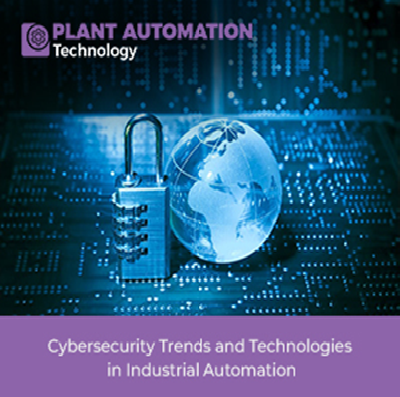Cybersecurity Trends and Technologies in Industrial Automation

Introduction
Industrial automation has transformed sectors like manufacturing, energy,transportation, and healthcare, improving productivity and cost-effectiveness. However, this increased reliance on interconnected systems exposes them to cybersecurity vulnerabilities. This article explores the latest trends and technologies in cybersecurity, focusing on protecting industrial automation systems from malicious attacks. It discusses the challenges posed by the Industrial IoT (IIoT) and emphasizes strategies like Zero Trust Architecture (ZTA). Enhanced network segmentation, robust endpoint security, and continuous monitoring are highlighted as crucial measures. By prioritizing cybersecurity, organizations can safeguard their operations and mitigate risks in the digital age.
Rise of Industrial IoT and Security Challenges:
With the rapid expansion of the Industrial Internet of Things (IIoT), the industrial landscape has undergone a significant transformation, resulting in improved connectivity, efficiency, and productivity. However, this increased connectivity also brings unique cybersecurity challenges for industrial automation systems. Organizations must tackle the following security challenges to protect their critical infrastructure effectively:
| Also Read: Safeguarding Your Smart Manufacturing: Tackling Cybersecurity Challenges |
Securing IIoT environments poses a notable challenge due to the sheer volume of connected devices. Each device represents a potential entry point for cyber attackers, underscoring the need for comprehensive security measures throughout the network. Complicating matters further, numerous IIoT devices are legacy systems with limited security capabilities, rendering them attractive targets for malicious actors. To mitigate these risks, organizations must implement robust security strategies that encompass both legacy and modern devices within the IIoT ecosystem.
A. Enhanced Network Segmentation
Network segmentation plays a crucial role in preventing lateral movement and containing potential cyber threats within industrial automation environments. By dividing networks into logical segments, organizations can restrict unauthorized access and mitigate security breaches.
Segmentation helps create secure zones within an industrial automation network, separating critical systems from less sensitive ones. This approach limits the potential attack surface and restricts malware spread. Moreover, implementing strict access controls and monitoring mechanisms within each segment enhances visibility and simplifies incident response.
B. Adoption of Zero Trust Architecture
Industrial automation systems require perimeter-based security solutions. By implementing rigorous access controls and constant authentication at every level, the Zero Trust Architecture (ZTA) presents an effective alternative. This method ensures that only authorized individuals and entities have access to vital resources and data.
The Zero Trust Architecture philosophy is "never trust, always verify." It implies that no network user or device can be implicitly trusted and requires authentication and authorization for all access requests. Organizations can dramatically minimize the risk of unauthorized access and lateral movement by using granular access restrictions, multifactor authentication, and least privilege principles.
C. Endpoint Security Importance
Endpoints, such as programmable logic controllers (PLCs) and human-machine interfaces (HMIs), are often the primary targets for cyberattackers. Robust endpoint security measures, including secure coding practices, regular patching, and firmware updates, are vital for protecting these devices from exploitation and unauthorized access.
Securing endpoints involves a multi-layered approach. Organizations should adopt secure coding practices to eliminate common vulnerabilities and regularly update firmware and software to address known vulnerabilities. Additionally, implementing strong access controls, intrusion detection systems, and encryption mechanisms for communication between endpoints and other network components adds an extra layer of protection.
D. Threat Intelligence and Monitoring
To detect and respond to emerging cyber threats effectively, industrial automation systems require continuous monitoring and threat intelligence capabilities. Real-time monitoring, security information and event management (SIEM) solutions, and advanced analytics help identify and mitigate potential risks before they escalate into major security incidents.
Implementing robust monitoring solutions allows organizations to detect anomalous behavior, unauthorized access attempts, and suspicious network activities promptly. By leveraging threat intelligence feeds and integrating them with monitoring systems, organizations gain insights into the latest threats and can proactively update their defenses. Additionally, advanced analytics and machine learning algorithms help identify patterns and anomalies, enabling timely incident response.
E. Leveraging Artificial Intelligence and Machine Learning
Industrial automation and cybersecurity are changing with Artificial Intelligence (AI) and Machine Learning (ML) technologies. These advancements revolutionize organizations' system protection. AI-powered algorithms play a crucial role in anomaly detection, attack prediction, and automated threat response, enabling proactive defense against sophisticated threats.
AI and ML analyze vast volumes of data from multiple sources like network traffic, logs, and user behavior. By leveraging this data, these technologies can identify patterns that indicate potentially malicious activities. AI and ML can predict and anticipate potential threats using historical data to generate real-time alerts. Additionally, AI-driven automated response systems can swiftly contain and mitigate attacks, minimizing response times and reducing security incidents' impact.
AI and ML integration in industrial automation and cybersecurity empowers organizations to stay one step ahead of emerging threats and fortify their overall security posture. By harnessing these technologies, organizations can effectively defend against evolving cyber risks and enhance system resilience.
F. Continuous security training and awareness
Human error remains a significant vulnerability in industrial automation security. Regular security training and awareness programs are essential to educating employees about best practices, phishing attacks, and social engineering techniques. By fostering a security-conscious culture, organizations can significantly reduce cyber intrusion risk.
Employees at all levels should receive comprehensive security training to understand their role in cybersecurity. This includes recognizing and reporting suspicious emails or activities, following password hygiene practices, and understanding the potential consequences of security breaches. By promoting a culture of vigilance and accountability, organizations can create a strong human firewall against cyber threats.
| Also Read : Instrumentation Companies and Cybersecurity in the Era of Smart Manufacturing |
Conclusion
As industrial automation advances, cybersecurity becomes a top priority. Embracing the latest trends and technologies is crucial to enhancing systems. Robust network segmentation, Zero Trust Architecture, and endpoint security protect against attacks. Continuous monitoring and threat intelligence enable timely response. Training employees on best practices and fostering awareness mitigates risks. By prioritizing cybersecurity investments and staying proactive, organizations can secure industrial automation's future, driving innovation and progress.







